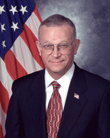The National Communications System has expanded coverage for Wireless Priority Service into western and northeastern states and Hawaii.WPS moves national security and emergency officials in 15 cities to the head of the line for cellular calls during crises. It is the cellular equivalent of the Government Emergency Telecommunications Service, which provides priority wireline service to national security and emergency personnel.New software for wireless switches used by WPS carrier T-Mobile USA Inc. of Bellevue, Wash., will give authorized personnel in 15 cities a better than 95 percent chance of completing cell calls during extreme congestion, said John Graves, the WPS project head and Government Emergency Telecommunications Service program director. WPS is an extension of GETS.'The improvement from queuing [calls] is enormous,' Graves said.Graves said he expects to add other carriers soon. They eventually could serve as many as 70,000 federal, state and local government users and key private-sector officials.An initial stopgap offering of limited wireless priority service began in Washington and New York after Sept. 11, 2001, and in Salt Lake City for the 2002 Olympics. A second, more advanced phase rolled out in January to users in 15 T-Mobile markets across the south and in Boston and Philadelphia.The latest expansion adds areas around Albuquerque, N.M.; Austin, Texas; Chicago; Cincinnati; Dallas; Denver; Detroit; Honolulu; Milwaukee; Oklahoma City; Salt Lake City; Tulsa, Okla.; and Wichita, Kan. Service also is available throughout Connecticut, in southern and central Pennsylvania, upstate New York and west Texas.Authorized users in federal, state and local governments and private organizations go to the head of the queue for an open channel when they dial a WPS prefix with a number. That raises their chances of completing a call during network congestion. Priority calls do not pre-empt calls in progress, however, so WPS cannot monopolize cellular service during an emergency.NCS contracted with T-Mobile for the service through DynCorp of Reston, Va., the WPS integration contractor. Priority service is now available only on Global System for Mobile Communications networks. NCS plans to add carriers using Code Division Multiple Access, the dominant U.S. cellular technology.'It's all voluntary,' Graves said. 'Not a single carrier came to us and said, 'We're interested in doing this.' There was no business case for it, because the cost per call would be hundreds or thousands of dollars' for a relatively small number of customers nationwide.All that changed in 2001, however.'After Sept. 11 it was more than a business case,' Graves said. 'It was a compelling need.'NCS got a $200 million budget with orders to provide service for Washington and New York City within 60 days.'This was the right thing to do,' said Gary K. Jones, T-Mobile director of standards policy. 'It was needed by the country, and we were willing to offer the service.'T-Mobile and Globalstar LP of San Jose, Calif., a satellite phone provider, organized the service for Washington and New York. Globalstar heavied up its satellite capacity and landline trunking, which also served 600 users in Salt Lake City for the 2002 Winter Olympics.T-Mobile provided queuing for priority users in the initial phase. If the cellular system is congested when a priority user tries to call, that call goes to the head of the queue for the next available channel on the nearest cell.By May 2002, the service could be invoked on every call made from a WPS subscriber's cell phone, rather than on a call-by-call basis. T-Mobile required an FCC waiver for that.With about 4,000 subscribers in Washington and New York when the waiver expired Dec. 31, T-Mobile reached its deadline for initial nationwide operation.Priority service is invoked only when a subscriber dials a *272 prefix on a T-Mobile phone. Also, priority applies only to the connection with the nearest cell.The deadline for full operational capability is this December. That means end-to-end priority service from the caller's phone throughout the cellular and interexchange landline networks to the number dialed.There still is no business case for the service. 'We are trying to make sure it doesn't cost us a lot of money, but it's certainly not a moneymaker for us,' Jones said.To see that the companies do not lose money, NCS is funding development of the switch software.T-Mobile uses GSM's Multi-Level Precedence and Pre-emption feature enables queuing for priority access. Ericsson Inc. of Plano, Texas, developed pre-emption software for its switches used by T-Mobile in Washington and New York.Last month NCS told the White House that with its $200 million budget it could develop nationwide WPS service for either GSM or Code-Division Multiple Access cellular networks, but not for both. Fielding a CDMA system would probably have been cheaper, but queuing was already incorporated in GSM, and the early deployment in Washington and New York had given the carriers some experience.'We could go either way, but our best guess was GSM,' Graves said.T-Mobile's initial 15 cities all have Ericsson switches. The service will be available elsewhere when software is ready for switches from Nortel Networks Corp. of Brampton, Ontario, and Nokia Inc. of Irving, Texas.'It's a fairly substantial work effort' to develop the software, Jones said.WPS subscribers will be limited to no more than 1 percent of the carrier's customer base, Graves said. With 8.9 million customers, T-Mobile should have plenty of bandwidth to accommodate the current 70,000 GETS users.Other interested carriers such as AT&T Wireless Services Inc., Cingular Wireless and Nextel Communications Inc. are converting to GSM. 'We have not given up hope that we could get funded for CDMA,' Graves said. 'Our long-range object is to do this on the entire cellular network.'
'We have not given up hope that we could get funded for CDMA. Our long-range object is to do this on the entire cellular network.'
'John Graves, WPS project head







